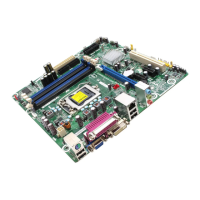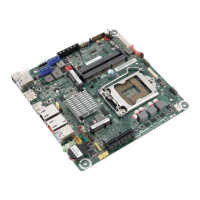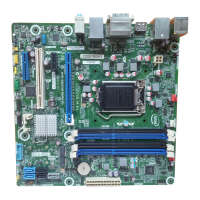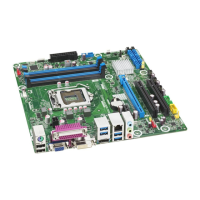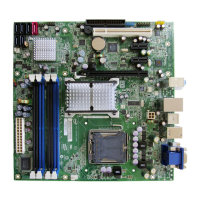Intel Desktop Board DQ67SW Product Guide
10
Table 1. Feature Summary (continued)
Peripheral
Interfaces
• Fourteen USB ports:
― Two USB 3.0 ports are implemented with stacked back panel
connectors (blue)
― Four USB 2.0 ports are implemented with stacked back panel
connectors (black)
― Eight USB 2.0 front panel ports are implemented through four
dual-port internal headers
• Six SATA interfaces through the Intel Q67 Express Chipset with
Intel
®
Rapid Storage Technology RAID support:
― Two internal SATA 6 Gb/s ports (blue)
― Two internal SATA 3 Gb/s ports (black)
― Two backpanel eSATA 3 Gb/s ports (red)
• One serial port header
• Two IEEE 1394a ports:
― One IEEE 1394a port header
― One backpanel IEEE 1394a port
LAN Support Intel
®
82579LM Gigabit (10/100/1000 Mb/s) Ethernet LAN controller
with support for:
• Intel
®
Active Management Technology (Intel
®
AMT) 7.0
• ASF 2.0
Legacy I/O
• Nuvoton* W83677HG-i I/O controller for hardware management
and serial port support
BIOS
• Intel
®
BIOS resident in an SPI Flash device
• Support for Advanced Configuration and Power Interface (ACPI),
Plug and Play, and SMBIOS
Instantly Available
PC Technology
• Support for PCI Local Bus Specification, Revision 2.2
• Support for PCI Express Base Specification, Revision 2.0
• Suspend to RAM support
• Wake on Conventional PCI, PCI Express, LAN, front panel, serial,
and USB ports
Hardware
Monitoring
• Hardware monitoring through the Nuvoton I/O controller
• Voltage sense to detect out of range power supply voltages
• Thermal sense to detect out of range thermal values
• Three fan headers using PWM control
• 4-pin headers for processor, front chassis, and rear chassis fans
• 4-wire and 3-wire (linear) fan speed control support for front and
rear chassis fans
• Support for Platform Environmental Control Interface (PECI)
Intel
®
vPro™
Technology
• Intel
®
Active Management Technology (Intel
®
AMT) 7.0
• Intel
®
Trusted Execution Technology (Intel
®
TXT)
• Intel
®
Fast Call for Help (Intel
®
FCFH)
• Intel
®
Virtualization Technology (Intel
®
VT)
• Intel
®
Virtualization for Directed I/O (Intel
®
VT-d)
• Hardware-based Keyboard-Video-Mouse (KVM)
